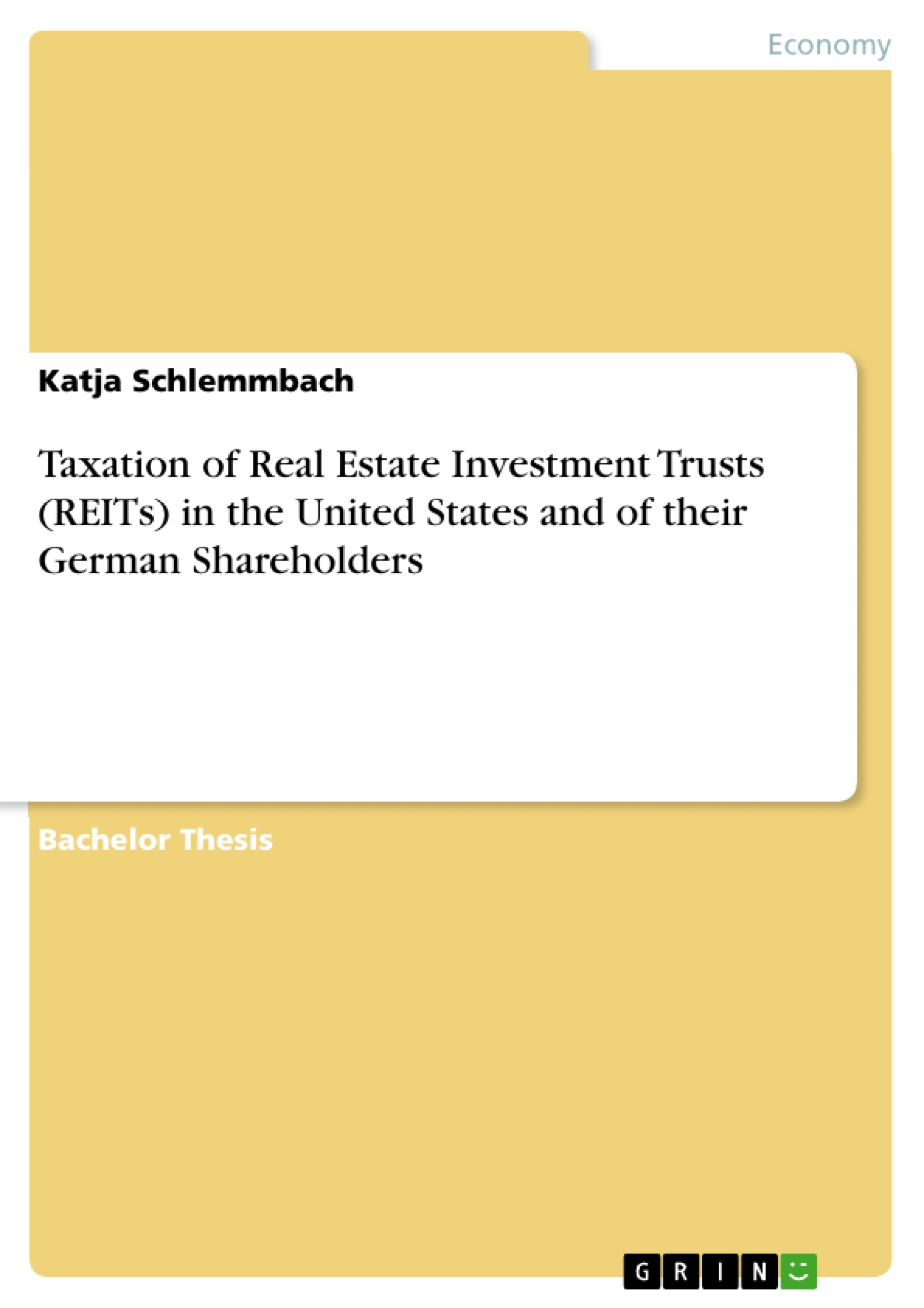Die Arbeit beschäftigt sich mit den besonderen Vorschriften des US-Steuerrechts für REITs. Außerdem werden das deutsch-amerikanische DBA und Provisionen des dt. Steuerrechts für Anleger des US-REITs betrachtet. - This thesis treats the provisions of the US tax lax concerning REITs and the provisions of the DTA and the US and the german tax law regarding the shareholders of those REITs.
Table of Contents
- INTRODUCTION
- PROBLEM DEFINITION
- APPROACH OF INVESTIGATION
- GENERAL INFORMATION ABOUT REITS
- DEFINITION OF REAL ESTATE INVESTMENT TRUSTS
- REIT HISTORY/LEGAL DEVELOPMENTS
- TYPES OF REITS
- SPECIAL REIT STRUCTURES
- Umbrella PartNERSHIP REITS
- DOWNREITS
- ECONOMIC PERFORMANCE AND INDUSTRY GROWTH
- PREREQUISITES TO BE TAXED AS A REIT IN THE U.S
- ORGANIZATION
- GENERAL STRUCTURE
- Paired Stocks
- Paper-Clips
- MANAGEMENT
- Trustees and Directors
- Shareholder Rights
- REIT OWNERSHIP
- Ownership of Shares and its Restrictions
- Domestic Corporation
- Banks and Insurances
- Number of Shareholders
- Closely Held Prohibition
- ELECTION TO BE TAXED AS REIT
- CONVERSION OF "C CORPORATION"
- ASSET TESTS
- 75% TEST
- 25% TEST
- FAILURE OF THE ASSET TESTS
- INCOME TESTS
- GROSS INCOME
- 75% TEST
- 95% TEST
- FAILURE OF THE INCOME TESTS
- TAXABLE REIT SUBSIDIARIES (TRS)
- GENERAL INFORMATION
- EFFECTS ON ASSET AND INCOME TESTS OF A REIT
- DISTRIBUTION REQUIREMENTS
- GENERAL INFORMATION
- DISTRIBUTION OF STOCK
- CAPITAL GAIN DIStributions
- DISTRIBUTIONS AT A LATER DATE
- TAXATION OF A REIT
- GENERAL INFORMATION
- FILING THE RETURN
- TAX PAYMENTS
- FAILURE TO COMPLY
- ACCOUNTING METHOD AND PERIOD
- INCOME TYPES
- REIT TAXABLE INCOME
- DEDUCTIONS FOR DIVIDENDS PAID
- EARNINGS AND PROFITS
- EXCESS NON-CASH INCOME
- CAPITAL GAINS
- NET OPERATING LOSSES
- NET CAPITAL LOSSES
- INCOME FROM FORECLOSURE PROPERTY
- INCOME FROM PROHIBITED TRANSACTIONS
- INCOME THROUGH CHANGES OF ACCOUNTING METHOD
- CALCULATION OF FEDERAL TAX LIABILITY
- TAXES ON REITTI INCLUDING CAPITAL GAINS
- TAX ON NET INCOME FROM FORECLOSURE PROPERTY
- TAX ON INCOME FROM PROHIBITED TRANSACTIONS
- TAX ON GAINS THROUGH C CORPORATION CONVERSIONS
- EXCISE TAX ON UNDISTRIBUTED INCOME
- PENALTY TAXES FOR FAILURE OF ASSET OR INCOME Tests
- PENALTIES FOR FAILURE OF OWNERSHIP
- PENALTY TAXES FOR CERTAIN DEALINGS WITH TRS
- Alternative Minimum Tax
- TAXATION THROUGH STATES
- IMPORTANCE OF FEDERAL LAWS FOR STATES
- CONNECTION BETWEEN REIT AND STATE
- BUSINESS IN MORE Than One STATE
- DIVISION OF INCOME FOR TAX PURPOSES
- TAXATION OF SHAREHOLDERS
- US SHAREHOLDERS
- DISTRIBUTIONS FROM EARNINGS AND PROFITS
- CAPITAL GAINS DIVIDENDS
- RETAINED CAPITAL GAINS
- CAPITAL GAINS TAX RATES
- QUALIFIED DIVIDENDS
- TAX-EXEMPT SHAREHOLDERS
- GERMAN SHAREHOLDERS
- GENERAL REGULATIONS FOR FOREIGN SHAREHOLDERS
- United States Real Property Interest
- Capital Gains Distributions
- Ordinary Dividends
- Penalties
- DOUBLe Taxation TreATY USA-GERMANY
- General Information
- Ordinary Dividends
- Gains through Disposition of Shares
- GERMAN INCOME TAXATION
- Provisions of the German REIT Act and Income Taxation
- Corporate Investors
- Individual Investors
- Contrast of the Tax Regimes
- FUTURE FORECAST AND CONCLUSION
- Taxation of REITs in the United States
- Tax implications for German shareholders
- Legal framework and relevant tax treaties
- Comparison of the tax regimes for REITs and shareholders
- Future forecast and potential challenges
- Introduction: This chapter outlines the thesis's research problem, which focuses on the taxation of REITs in the United States and the tax implications for their German shareholders. It also defines the research approach, including the methodology used to investigate the topic.
- General Information about REITs: This chapter provides a comprehensive overview of REITs, including their definition, historical development, types, special structures, and economic performance. It discusses key legal developments and the factors contributing to industry growth.
- Prerequisites to be Taxed as a REIT in the U.S.: This chapter delves into the various requirements that must be met for an entity to qualify as a REIT for tax purposes in the United States. It explores the organizational structure, management, ownership, asset tests, income tests, and distribution requirements.
- Taxation of a REIT: This chapter examines the tax implications for REITs in the United States. It focuses on filing requirements, tax payments, compliance issues, accounting methods, different types of income, and the calculation of federal tax liability. It also discusses various penalties and the role of state taxes in REIT taxation.
- Taxation of Shareholders: This chapter explores the tax consequences for both U.S. and German shareholders who invest in REITs. It examines the treatment of distributions, capital gains dividends, retained capital gains, and tax rates for shareholders. It also delves into the implications of tax treaties, particularly the double taxation treaty between the United States and Germany.
Objectives and Key Themes
This bachelor thesis examines the taxation of Real Estate Investment Trusts (REITs) in the United States and the tax implications for their German shareholders. It aims to provide a comprehensive understanding of the legal framework, tax regulations, and relevant tax treaties involved.Chapter Summaries
Keywords
This bachelor thesis focuses on the taxation of Real Estate Investment Trusts (REITs) in the United States, highlighting the tax implications for German shareholders. Key concepts include tax treaties, double taxation, REIT structures, income tests, asset tests, distribution requirements, capital gains, and tax liabilities.
Ende der Leseprobe aus 99 Seiten
- nach oben
- Arbeit zitieren
- B.A. in International Business Katja Schlemmbach (Autor:in), 2008, Taxation of Real Estate Investment Trusts (REITs) in the United States and of their German Shareholders, München, GRIN Verlag, https://www.grin.com/document/186524
Blick ins Buch



